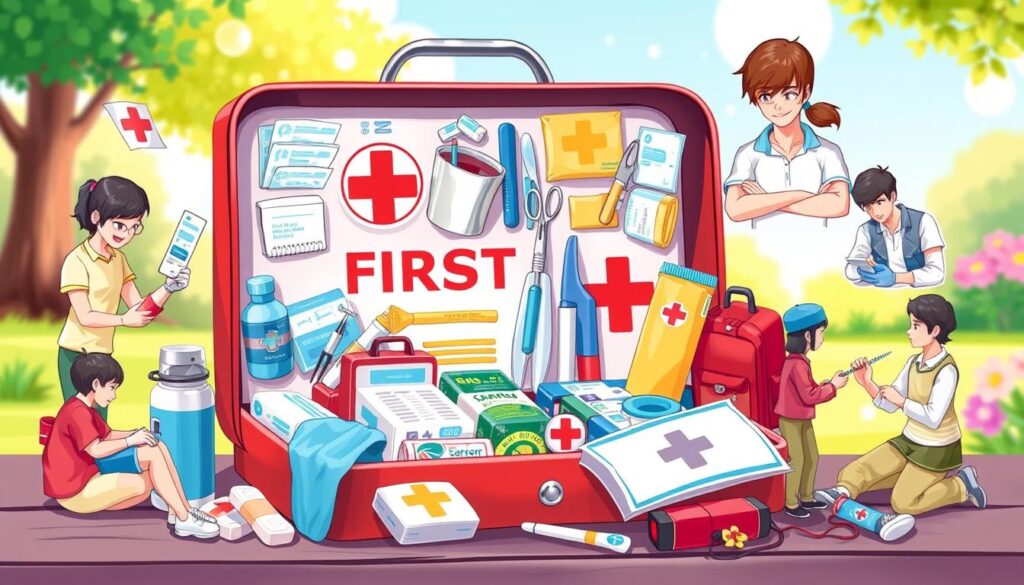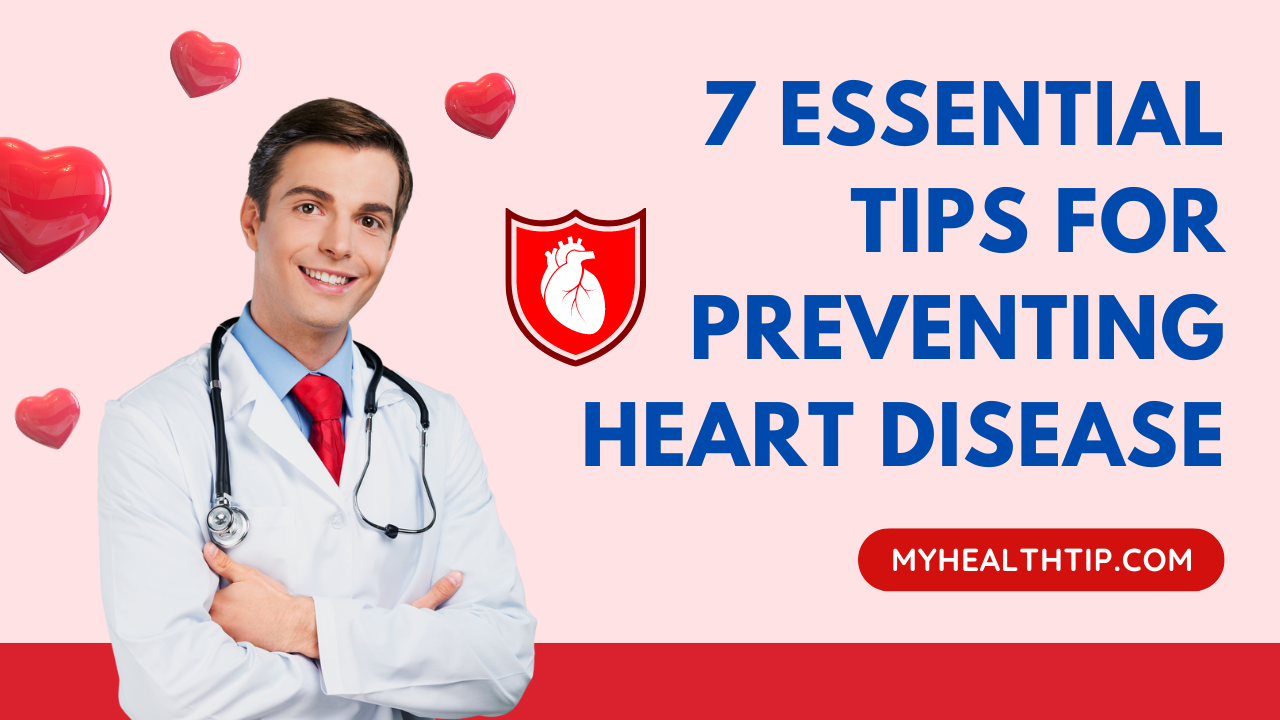In emergency situations, knowing first aid can be a lifesaver. It’s our duty to be ready and have the skills to protect our loved ones. This article will cover eight key first-aid tips for crisis moments.
Table of Contents

Key Takeaways
- Mastering essential first-aid techniques can save lives during emergencies.
- Understanding the importance of prompt action in medical crises can motivate us to stay calm and respond quickly.
- Stocking up on basic first-aid supplies at home ensures we’re ready to provide immediate care when needed.
- Knowing how to recognize heart attack symptoms and perform CPR can be crucial in cardiac emergencies.
- Proper wound care and bleeding control are essential skills for managing severe injuries.
Understanding the Importance of First-Aid Knowledge in Emergency Situations
In a medical emergency, every second is crucial. Knowing the right life-saving first-aid can change everything. It empowers us and our communities to act fast and save lives.
Why Every Second Counts in Medical Emergencies
Time is key in medical emergencies. Quick action can be the difference between life and death. Skills like stopping severe bleeding or doing CPR are vital. Being ready with first-aid skills can greatly improve the outcome and save lives.
Building Confidence to Act in Crisis Moments
Many fear acting in emergencies due to lack of confidence or fear of mistakes. But, basic life-saving skills can make a big difference. Learning and practicing first-aid builds confidence to act when it’s most important. Being ready and willing to help can be the key to saving a life.

“The greatest good we can do for others is not just share our riches, but to reveal to them their own.”- Benjamin Disraeli
Having first-aid knowledge and the courage to act can empower us. It lets us be the heroes in emergency situations. By understanding the urgency and gaining confidence, we can change our communities and make a real difference in people’s lives.
Essential First-Aid Supplies Every Home Should Have
Being ready for emergencies is key to keeping our families safe. A well-stocked first-aid kit is a crucial part of emergency preparedness. It can help us respond quickly and avoid panic in a crisis. Let’s look at the important items every home should have for home safety.
A good first-aid kit should have these essential items:
- Adhesive bandages in various sizes
- Gauze pads and rolls
- Antiseptic wipes or cream
- Antibiotic ointment
- Pain relievers (acetaminophen, ibuprofen)
- Thermometer
- Tweezers and scissors
- Medical tape
- Sterile eye wash solution
- Cold pack
- CPR mask or face shield
- Disposable gloves
These items help us handle many emergency preparedness situations. They cover everything from small cuts to serious injuries. Having them ready means we can give quick and effective first-aid care until help arrives.
| Item | Purpose |
|---|---|
| Adhesive bandages | Cover and protect minor cuts and abrasions |
| Gauze pads and rolls | Apply pressure to control bleeding and protect wounds |
| Antiseptic wipes or cream | Clean and disinfect wounds to prevent infection |
| Pain relievers | Alleviate pain and reduce inflammation |
| CPR mask | Provide a barrier during rescue breathing and CPR |
A well-stocked first-aid kit is vital for any home safety plan. With these supplies, we can act fast and confidently in medical emergencies. This can save lives and prevent more harm.

Responding to Cardiac Emergencies and CPR Basics
Knowing how to act in a medical crisis is crucial. It can mean the difference between life and death. It’s important to recognize heart attack symptoms, follow CPR steps, and use an Automated External Defibrillator (AED) correctly.
Recognition of Heart Attack Symptoms
Spotting the signs of a heart attack is key to quick care. Look out for:
- Chest pain or discomfort
- Shortness of breath
- Nausea or vomiting
- Lightheadedness or dizziness
- Arm or back pain
Step-by-Step CPR Guidelines
When someone has a cardiac emergency, CPR is vital. Here’s how to do it right:
- Call 911 or your local emergency number.
- Start chest compressions at 100-120 per minute, pressing down 2 inches (5 cm) on the chest.
- Give 2 rescue breaths after 30 chest compressions.
- Keep going until they breathe or move, or help arrives.
Using an AED Effectively
An Automated External Defibrillator (AED) can save lives. Here’s how to use it:
- Turn on the AED and follow the voice prompts.
- Expose the person’s bare chest and apply the adhesive electrode pads as directed.
- Stand clear and let the AED check the heart rhythm.
- If it says to, press the shock button and deliver the shock.
- Start CPR again right after, or if no shock is needed.
Learning these skills can help you save a life. Remember, practice and keep up with new guidelines are key.
| Cardiac Emergency Technique | Key Steps |
|---|---|
| CPR | Call 911 Begin chest compressions (100-120 per minute) Provide 2 rescue breaths Continue until help arrives or person responds |
| AED Use | Turn on AED and follow voice prompts Apply adhesive electrode pads Stand clear and allow AED to analyze rhythm Deliver shock if advised Resume CPR immediately after |
“Immediate CPR can double or triple a person’s chance of survival from sudden cardiac arrest.”
Managing Severe Bleeding and Wound Care
In emergency situations, knowing how to manage severe bleeding and wound care is crucial. It can be the difference between life and death. Let’s look at some key first-aid techniques for these critical medical concerns.
Stopping Severe Bleeding
When you face severe bleeding, stopping the blood flow is the main goal. Here are the steps to follow:
- Apply direct pressure to the wound with a clean cloth or bandage. Press firmly and continuously until the bleeding stops.
- If the bleeding doesn’t stop, add more pressure by wrapping a bandage or cloth tightly around the area.
- If the bleeding is from an arm or leg, elevate the limb above the heart. This helps reduce blood flow to the wound.
- In extreme cases, use a tourniquet to restrict blood flow to the affected area, but only as a last resort.
Proper Wound Care
After stopping the bleeding, clean and dress the wound to prevent infection. Here’s how:
- Clean the wound by gently rinsing it with clean water or a saline solution to remove dirt or debris.
- Apply an antiseptic like hydrogen peroxide or antibiotic ointment to kill bacteria and prevent infection.
- Cover the wound with a sterile bandage or dressing to keep it clean and protected.
- Watch the wound for signs of infection, such as redness, swelling, or pus. Seek medical attention if you see these signs.
Remember, quick and proper wound care and bleeding control are key in first-aid emergencies. By learning these techniques, you can save lives when it counts most.
“The first few minutes after a severe injury can mean the difference between life and death. Knowing how to stop bleeding and care for wounds can be a true lifesaver.”
8 Life-Saving,first-aid,tips,everyone,
In emergency situations, knowing first-aid can save lives. It’s about bandaging wounds and getting medical help fast. Here are key first-aid tips everyone should know.
Proper Bandaging Techniques
Bandaging is crucial for treating injuries. It stops bleeding and protects the wound. Here’s how to do it right:
- Clean the wound with clean water or saline to remove dirt.
- Put a sterile dressing or gauze pad on the wound.
- Wrap the bandage firmly but not too tight to keep it in place.
- Elevate the injured area to reduce swelling and bleeding.
- Check the bandage often and change it if it gets wet or loose.
When to Seek Professional Help
While first-aid can handle many small emergencies, some cases need a doctor. Look out for these signs to know when to get help:
- Severe bleeding that can’t be stopped with pressure
- Suspected broken bones or dislocated joints
- Difficulty breathing or signs of trouble breathing
- Being unconscious or not responding
- Any injury that looks serious or needs special medical care
In emergencies, quick first-aid and medical help are key. Stay calm, act fast, and call for help when needed.
Dealing with Choking and Respiratory Distress
Choking and respiratory emergencies are scary, but knowing how to react can save lives. We’re here to teach you the key steps to handle these emergencies.
Recognizing the Signs of Choking
First, you need to know the signs of choking. Look for people who can’t cough, speak, or breathe right. They might be clutching their throat, turning red, or making strange sounds. It’s very important to act fast, as choking can be deadly.
Performing the Heimlich Maneuver
The Heimlich maneuver can help clear an airway blockage. Here’s how to do it:
- Stand behind the person and place one fist just above their navel.
- Grasp your fist with your other hand and give a quick, upward thrust.
- Keep repeating the thrusts until the blockage is cleared or the person loses consciousness.
If the person loses consciousness, start CPR right away. Begin with chest compressions.
Addressing Respiratory Emergencies
For severe respiratory issues like asthma attacks or anaphylactic shock, quick action is key. Help the person use their medication, like an inhaler or epinephrine auto-injector. If their breathing gets worse, call emergency services right away.
| Symptom | Response |
|---|---|
| Choking | Perform the Heimlich maneuver |
| Severe Asthma Attack | Assist with inhaler, call emergency services if needed |
| Anaphylactic Shock | Administer epinephrine auto-injector, call emergency services |
Being calm and quick can save lives in respiratory emergencies. Learning about choking response and respiratory emergencies will prepare you to use the Heimlich maneuver and other lifesaving techniques.
“When it comes to first-aid, the most important tool you have is your knowledge and the willingness to act.”
Conclusion
In this article, we’ve looked at why first-aid knowledge is so important. We’ve seen how crucial it is to act fast in emergencies. We’ve also learned how to handle severe bleeding, heart emergencies, and breathing problems.
Knowing how to handle emergencies can save lives. It’s not just about knowing what to do; it’s about being ready to act. By learning these skills, we can help others in critical moments.
We urge you to keep learning and practicing first-aid. Keep your skills sharp with training and online resources. Remember, your knowledge could be the difference between life and death for someone. Let’s all strive to be heroes by learning first-aid.
FAQ
Why is first-aid knowledge so important in emergency situations?
First-aid knowledge is key in emergencies. It can save lives. Knowing how to act quickly can make a big difference.
What are the essential first-aid supplies every home should have?
Every home needs a first-aid kit. It should include bandages, antiseptic wipes, and gauze pads. Also, have adhesive tape, scissors, tweezers, and over-the-counter meds like pain relievers and antihistamines.
How can we recognize the symptoms of a heart attack and respond effectively?
Knowing the signs of a heart attack is vital. Look for chest pain, shortness of breath, and nausea. If you think someone is having a heart attack, call 911 right away.
Be ready to do CPR if needed. Having an AED nearby can also save lives in heart emergencies.
What are the proper techniques for controlling severe bleeding and caring for wounds?
To stop severe bleeding, apply direct pressure to the wound. Use a clean cloth or bandage. If possible, elevate the injured area.
For wound care, clean the area well. Apply an antiseptic and cover with a sterile dressing. This helps prevent infection.
How can we respond effectively to choking and respiratory emergencies?
If someone is choking, do the Heimlich maneuver. Stand behind them, place one hand on their abdomen, and give quick thrusts. This should dislodge the object.
In respiratory emergencies, like trouble breathing, call 911. Provide support until help arrives.





